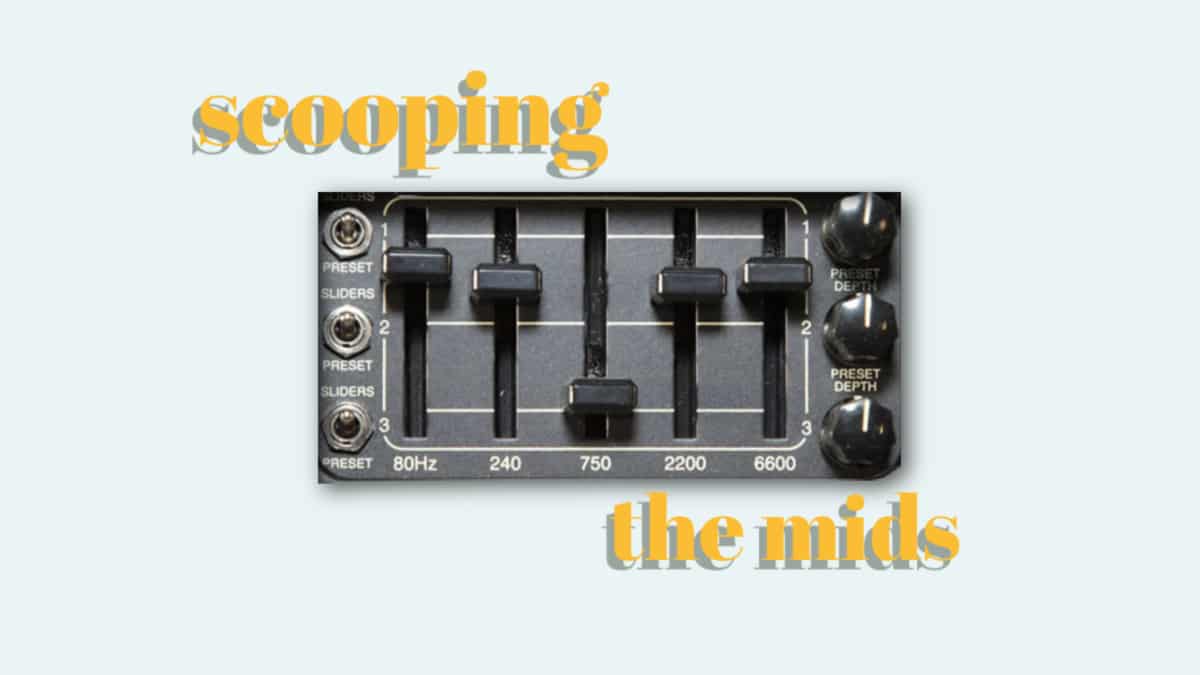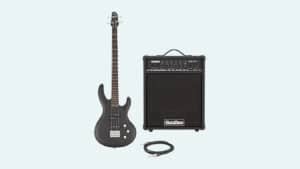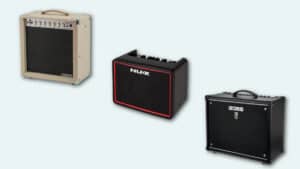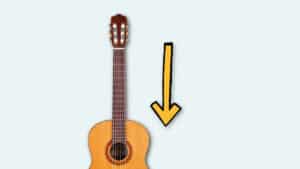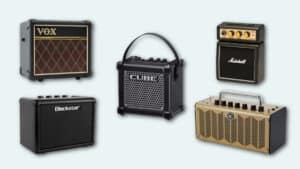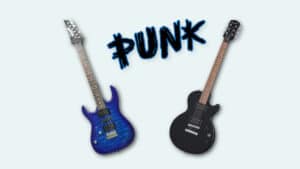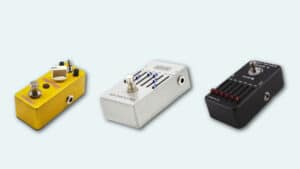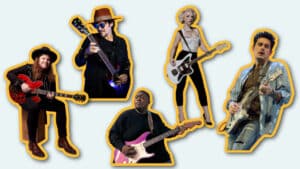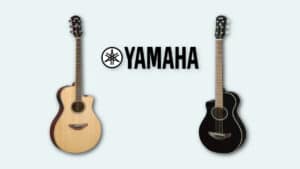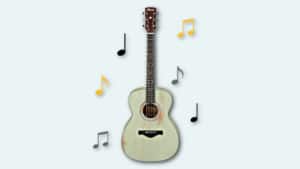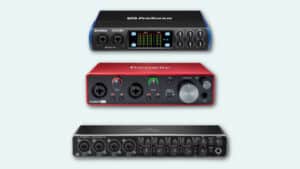What does it mean to scoop the mids on your amp?
Scooping the mids means cutting out the middle-range frequency on your guitar amp. This way, your guitar boasts a more stylized sound. Scooping the mids is a common technique in hard rock and metallic genres. Many players use this method when playing with others to stand out. But players must be careful to avoid encroaching on other musician frequency space, as it can cancel other instruments out.
If you’re a new guitar player, you might have heard of the phrase cutting through the mix or scooping the mids. Really, what those phrases mean is to alter your amps frequency to create a stylized tone or to stand out when playing with many other instruments.
In this article, I’ll explain what scooping the mids means, how to do it, why some guitar players choose to scoop their mids, and why others are so opposed.
What Is Scooping the Mids?
Picture this. You stroll into band practice, and your fellow bandmates tell you they can’t hear your guitar on the mix over the other instruments. Instead of cranking up the volume on your amp, they want you to scoop your mids. You’re like, huh?
What they mean is to alter your amps settings so you can be better heard on the mix. Scooping the mids means to manipulate tone and frequency to craft a unique, bolder sound.
Many people get confused when talking about scooping mids. This is because the concept of sound is so ethereal and can be difficult to process. So, let’s break these ideas down for a minute.
Imagine a giant rectangle. All the tones and frequencies the human ear can recognize occur on this rectangle. When you scoop the mids, you remove those middle frequencies. This emphasizes your guitars’ lower and higher frequencies.
Visually, scooped mids looks like a giant V shape on that rectangle since you’re dialing down (aka pulling down) the middle frequencies.
Now, remember that this manipulation happens on your amp. So, it’s not that the guitar itself loses its ability to play at those frequencies. Instead, it’s that you’re muting those middle frequencies on your amp.
What Is a Scooped tone?
A scooped tone is a tone that has already been altered. By having a scooped tone, the bass and treble range are more pronounced and built up, creating a stylized, distorted, or crunchy sound. Some amplifiers come with pre-set scooped tones, although this isn’t very common.
What Are the Mids?
The guitar is a mid-range instrument. This means it emits middle frequencies compared to low basses or high vocals). Still, it still has a wide frequency range. The guitar emits frequencies anywhere from 100 Hz to 6k Hz (or even higher depending on the amp).
When we’re talking about the middle tones, we’re talking about the range between 200 Hz and 4k Hz. As you can see, the mid-range takes up a vast swath of your guitar’s frequency range.
The lower range (200 Hz) emits a more natural, earthy tone. High 4k tones are very in-your-face, sharp, and bold. When you cut out the mid and amplify both the lower and higher tones, you get a crisp but bold, unique sound. Some players find this sound irresistible.
Is Scooping the Mids on Your Amp Bad?
Scooping the mids on your amp is not bad. It will not damage your amp, nor will it damage your guitar. But scooping your mids is hotly contested and is a very polarizing technique. As a result, many musicians have very extreme reactions and opinions on scooping mids.
Scooping the mids is a stylistic choice. It’s a way of amplifying specific frequencies and tones to give your guitar a distinct sound.
Scooping the mids can sometimes work very well. For example, it works well if you’re after a unique sound or if you’re playing hard, hair bender rock. Of course, if you’re playing warmer, folksy music, scooping your mids may not be the technique.
If anyone tries to tell you that scooping the mids on your amp is bad or wrong, point them to bands like Metallica.
How do you Scoop Mids?
All this source of controversy happens on your amp. Ironically, some amps have mids already scooped (or dialed back).
Your amp will have something called an equalizer on it (otherwise referred to as the EQ). The EQ will have a bass, mid, and treble knob. To cut out the mid-range, simply dial the middle knob close to zero or to a complete zero.
If you have an advanced amp, you can control your tones and frequencies more. This is where that “smile” expression comes from. This is when you push the left and right sliders all the way up, with the middle slider dipping below 30%. The result is a smile on your pedal.
How much should you scoop the mids? Like I always say, it always comes down to experimentation and personal preference.
Have fun and play around with the dials to see what level you like your mids on best.
Why Do Guitarists Scoop the Mids?
Deciding if you want to scoop the mids depends on your preference and your bands’ preference. The goal, always, is to make your band sound the best it can.
Of course, you want your guitar to sound its best, too. But sometimes you will need to make compromises to ensure the music has achieved your bands’ sound and vision.
If you haven’t figured it out by now, scooping mids is fiercely debated amongst guitar players. Some players swear by scooping mids to be heard when playing with others. But, some players swear by keeping all the sound levels equal to be heard when playing with others.
So, who’s right?
The truth is both are right. Whether to scoop the mids depends on the situation, player preference, and other instruments.
Benefits to Scooping the Mids
There are many benefits to scooping the mids; for one, you produce a stylized, hardcore sound. Depending on the genre of music you play, scooping the mids can be one way to elevate your sound to the next level.
Another benefit is when you play in a band with many guitars or many other instruments.
Every instrument emits different frequencies and tones. The drums, for example, emit lower tones, while cymbals and vocals go up higher. The guitar sits in the middle range.
Let’s say that you’re playing in a band with many instruments and even multiple guitars. In music, there’s only so much audio space available. Since guitars play on the same frequency, suddenly you find yourself competing for precious audio space. As a result, your sound may get canceled out by, say, the lead.
When you scoop out the mids, you’re playing at a different tone. This means that you might find space in a place where others aren’t playing at– even your fellow guitarists.
By cutting the mids, you can allow the lead guitarist to continue playing at those mid-ranges while you rock out on different frequencies. Ultimately, this allows you to carve space and sound for yourself. That way, you and the other players won’t drown each other out.
Drawbacks to Scooping the Mids
At its core, the guitar is a middle-range instrument. As a result, it’s the anchor holding the entire band down. While other instruments go low and high, the guitar is the steady rock that cruises in the middle.
Sometimes, you can play with many people and find that your guitar gets muddled when you scoop the mids. Worse, other instruments can get muddled. Why does this happen? Because you’re infringing on their frequency spot.
As I mentioned above, there’s only so much audio space available. If you have a bassist and a drummer and your lower tones are bigger, you may be in their frequency zone.
As a result, the audience (and each other) won’t be able to hear the differences in the instruments. This is because you’re all canceling each other out. That’s enough to anger off your bandmates, and that’s enough to get yourself frustrated.
Additionally, sometimes a scooped guitar can sound too junky or stylized. This happens if you scoop the frequencies to extremes.
Still, keep experimenting. When playing alone, there are little to no drawbacks to scooping your mids. And, if you like the sound of scooped mids, you can find a way to integrate that sound with your band.
Just make sure to collaborate, be respectful of other instruments, and keep an open mind.
When to Scoop the Mids
As you guessed from the previous section, scooping the mids depends on personal preference and whether you’re playing in a band.
Some people go into band practice with pre-scooped mids and then wonder why they can’t hear their instrument. Other guitarists don’t scoop the mids and then wonder why they can’t hear their guitar against the other guitars also playing.
Suddenly, you’re cranking up the volume louder and louder, forcing the other instruments to crank their volume up, too. Next thing you know, your eardrums are blown, your singer’s voice is drowned out, the audience gets a migraine, and the venue throws you out.
Instead of all this, simply experiment with tones to see if this solves the problem.
If you’re a bedroom player and just like emulating those hardcore songs from the ’80s, scoop away!
Personally, I’m a firm believer in experimenting with sounds until you find a tone you like. Keep in mind, though, that the tone that works in your insulated basement studio may not work live or in concert with other instruments and frequencies.
What Guitarists Are Famous for Scooping the Mids?
Ah, the ’80s. A time with big hair, big attitude, and big music.
Since the beginning of music, people have played around with tones and instruments to craft the best sounds. But the term of scooping the mid was coined back in the ’80s when Metallica used the technique on their famed song, “Master of Puppets.”
Then, many guitarists from the ’80s began to use this method, and it soon became a big trend in rock and heavy metal bands.
Metallica is the most famous pioneer for using scooped mids. Still, other bands have adopted this technique. For example, Avenged Sevenfold and Slipknot are bands that also scoop their mids.
Get Scoopin’
Experimenting with different tones is part of growing your skills as a guitarist. Though some players are adamant against scooping, it can be a fun tool to experiment with your sound. Additionally, it can be a great way to carve out a space in the audio or mix.
Still, players should be flexible with their tones when playing in a band. If you’re playing in a band with many instruments, be mindful that the mid-range is where guitars are “meant” to be. If you stray too much, you may end up canceling out the sound of your fellow bandmate’s instrument.
FAQs
What do mids do on a guitar amp?
The mid knob controls the middle frequency on your guitar. Next to the central knob will be other knobs that say bass and treble. These knobs control (you guessed it) the lower and higher frequencies of your amp. If you turn down the mid, you reduce the middle frequencies. If you turn up the mid knob, you gain more middle frequencies.
What does scooped mids sound like?
A scooped mid-tone sounds stylized, bigger, fuller, and sharper. This is because you’re emphasizing those higher frequencies (the frequencies that give crispness and brightness) and lower frequencies (the frequencies that provide boldness and fullness). Of course, the sound of a scooped mid dramatically depends on how much you dial down the mid-tones and how high you crank up the bass and treble tones. It also depends on the amplifier you’re using.
How do I get a good clean tone?
It’s all about playing around with the amplifier settings. One way to reduce the gain volume and turn off amp pedals and effects (as this creates a fuzzier, stylized tone). Make sure all your mid, basses, and treble knobs are set at the 12’o’clock range, and they’re all at equal intensity.
Are Marshall amps scooped?
Marshall apps have balanced EQ levels across the frequency spectrum. Some amps, though, do indeed come pre-scooped. For example, some Fender amps come mid-scooped.

